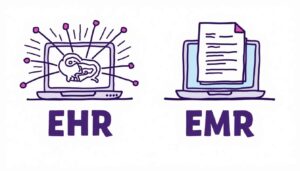Optimizing Revenue Cycle Management for Dental Practices
18 Oct 2025 By: Vlade Legaspi
Updated

In today’s tough healthcare market, dental practices must stay profitable while giving top care. Revenue cycle management for dental practices plays a key role in this. A strong RCM system boosts cash flow, cuts admin work, and improves patient service. This guide shares smart tools, tips, and strategies to help dental teams sharpen their revenue cycle management.
Understanding Revenue Cycle Management in Dental Practices

What is Revenue Cycle Management?
Revenue Cycle Management for dental practices, or RCM, covers the financial steps that healthcare providers take to handle patient care from the start. This includes things like registration and scheduling appointments all the way to getting the final payment on a balance. In dental practices, RCM handles a lot more details. It involves checking patient insurance coverage, making sure dental procedures get coded right, sending in claims, dealing with any denials, and collecting payments from patients.
People often think of RCM just as billing and collecting money. But it really touches every part of dealing with a patient. When RCM runs smoothly, dental offices get paid on time for the work they do. That helps keep the business going and allows for putting money into expanding. Dental practices can bring in technology to make RCM easier. This lets them automate tasks and cut down on mistakes from people. Staff then have more time to spend on taking care of patients. Tech like electronic health records systems helps manage patient info and billing in one place. Billing software also makes submitting claims a lot simpler.
Why is RCM Critical for Dental Practices?
Dental offices usually run on pretty tight budgets. That makes handling their revenue cycle really important for staying afloat. The American Dental Association says that practices which get their billing and collections sorted out can cut down claim denials by as much as twenty percent. This ends up boosting their cash flow in a big way. On top of that, all the different dental insurance setups and how much patients have to pay can cause some real headaches. If those things are not taken care of right, payments get held up and admin costs go through the roof.
Getting RCM optimized lets dental practices cut back on mistakes and speed up how fast they get paid. It also makes the whole financial side smoother for patients. Dentists can then spend more time on actual care instead of dealing with paperwork headaches. Good RCM setups even boost how happy patients feel by keeping billing clear and straightforward. When folks know exactly what they owe from the start, they tend to pay up without much fuss. That means fewer arguments and easier money matters overall. As these practices keep changing over time, the ones that put solid RCM plans first will protect their finances pretty well. They will also build stronger ties with patients through better talks and service.
Key Components of Dental Revenue Cycle Management

Patient Registration and Insurance Verification
The revenue cycle starts when a patient books a visit. In revenue cycle management for dental practices, accurate registration and insurance checks are key. Getting correct details early prevents costly claim rejections later.
Dental offices ought to make use of electronic tools for insurance checks that give instant info on coverage details, co-pays, deductibles, and any limits on benefits. This kind of clear picture lets the team talk straight with patients about what they will owe before any work gets done. On top of that, linking these tools into the practice management system smooths out the whole registration flow and cuts down on waiting around. It really improves how patients feel about the visit overall. When practices make sure folks know their insurance perks inside out, it builds up that sense of trust. Patients end up feeling like they matter and get taken seriously.
Accurate Coding and Documentation
Getting dental procedures coded right is key to fast payments. The ADA’s codes help explain services clearly. In revenue cycle management for dental practices, wrong or missing codes often cause claim delays or denials.
Dental providers must document all services, like radiographs and exams. In revenue cycle management for dental practices, trained coders help reduce errors and boost approvals. Regular audits catch issues early and keep coding current. A strong focus on accuracy and accountability protects income and improves how the practice runs.
Claims Submission and Follow-Up
Submitting claims electronically is now standard in revenue cycle management for dental practices. It speeds up processing and payments. But sending claims isn’t enough. You must follow up on denied or unpaid claims to stop lost revenue.
Dental offices need a strong system to track claim statuses. In revenue cycle management for dental practices, fast denial handling is key. Issues like bad coding, missing docs, or eligibility cause most denials. By spotting patterns, practices fix root problems. Analytics tools help show where claims get stuck. This makes the process run smoother. Regular staff training on claim trends improves denial handling and boosts revenue.
Patient Billing and Collections
These days, high-deductible health plans are common, and out-of-pocket costs keep rising. That makes patient payments key to revenue cycle management for dental practices. Clear cost talks, flexible payment plans, and timely bills help boost collections and support steady cash flow.
Practices can offer online payments, cost plans, and clear money advice. In revenue cycle management for dental practices, this reduces confusion and lifts collections. Trained front desk staff who talk kindly about costs build trust. That trust makes patients more likely to pay without stress.
Using reminders for payments or balances keeps cash flow steady. In revenue cycle management for dental practices, it feels helpful, not pushy. This boosts collections and builds patient trust. Strong ties lead to lasting relationships and more referrals.
Strategies to Optimize Revenue Cycle Management in Dental Practices

Implementing Advanced Practice Management Software
Modern dental software combines scheduling, billing, insurance checks, and reports. It automates revenue cycle management for dental practices. This reduces errors and eases admin work.
Tools like claim scrubbing, ERA, and payment reminders streamline the revenue process. In revenue cycle management for dental practices, full software boosts cash flow. It cuts down on delays in accounts receivable. Real-time reports help managers track key numbers fast. Cloud systems add secure storage and remote access, improving teamwork and office flow.
Staff Training and Role Specialization
Ongoing training keeps staff sharp on insurance rules and coding updates. In revenue cycle management for dental practices, clear roles boost skill and accountability.
Regular training and online tools help staff handle billing issues better. In revenue cycle management for dental practices, this cuts errors and speeds up payments. A learning culture builds teamwork and boosts skill sharing. Cross training adds flexibility, keeping the office on track during sick days or busy times. This steady setup strengthens long-term revenue.
Utilizing Data Analytics for Continuous Improvement
Data driven decision making turns out to be a strong way to improve revenue cycle management in dental offices. Practices can dig into important metrics like claim denial rates, the average time accounts receivable sit around, and patterns in how patients pay up. From there, they start spotting the real holdups and spots that need fixing.
Take a case where the numbers show a lot of denials tied to one specific procedure code. The office can then go over their documentation and coding habits to sort it out. In the same vein, keeping an eye on patient payment habits lets them tweak financial rules in a way that boosts collections. Plus, bringing in predictive analytics takes things further by using past data to predict what is coming next. Offices can shift their approaches early on to stay ahead. This proactive style really cuts back on potential problems. It also sets the practice up to take advantage of new possibilities showing up in the dental field.
Enhancing Patient Financial Experience
Patient satisfaction goes further than just the medical side of things. It includes how the financial part feels too. Clear talks about treatment costs, what insurance covers, and ways to pay help cut down on unexpected bills. That kind of openness really builds trust with patients.
Giving cost estimates upfront before any treatment starts makes a big difference. So do billing statements that are simple to read. Offering various payment methods helps too. All this can lead to better compliance when it comes to payments. On top of that, financial counseling or options from third parties give patients ways to handle their dental bills. Personalized touches like follow-up calls or emails after the visit keep them in the loop about money matters. It strengthens their grasp on responsibilities and builds loyalty in a way. Dental offices that set up a helpful financial setup not only boost satisfaction. They also get payments on time more often. In the end, this supports a stronger revenue flow overall.
Overcoming Common Challenges in Dental Revenue Cycle Management

Dealing with Insurance Complexity
Dental insurance plans differ quite a bit in what they cover, the caps on benefits, and the duties patients end up handling. Getting through all that mess calls for careful checks and straightforward talks. Dental offices need to stay current on the main insurance companies and their rules.
Setting up solid links directly with those insurance companies speeds things up for settling claims. Teaching patients what their coverage includes and where it falls short sets proper hopes and cuts back on slow payments. That kind of forward thinking boosts how happy patients feel, and it builds real trust too, since they come away knowing more and feeling stronger about their money side of things. Putting in a strong system for handling patients smooths out the checking part, so offices can size up coverage fast and let people know their personal costs right before any work starts.
Managing Claim Denials and Rejections
Claim denials happen no matter what, but they do not have to overwhelm a practice. The main thing comes down to setting up a clear system that spots the real problems behind them and puts fixes in place right away. Things like mistakes in eligibility checks, wrong codes on claims, or just plain missing paperwork show up as the usual culprits for these denials.
Dental offices really ought to keep a running log for all denials to spot those repeating issues and make sure someone owns the task of chasing them down. Getting corrected claims back out there quickly, along with solid appeals when needed, brings back money that would otherwise slip away and makes the whole revenue cycle management process run better overall. On top of that, holding regular training for the team on fresh coding changes and insurance rules cuts down a lot on the slip-ups that cause denials in the first place. Using tech like tools that automatically scrub claims before sending them off helps grab errors early on, which keeps rejections low and keeps the revenue flow steady and smooth.
Balancing Administrative Costs with Revenue Goals
Fixing up revenue cycle management can boost the money coming in, yet it usually means putting some cash into tech setups, staff training, and extra help around the office. Dental practices have to weigh those expenses carefully against the gains they expect to see down the line.
Running a solid cost-benefit check before jumping into new systems or ways of doing things makes sure the spending actually pays off with real results. Offices might look into handing off parts of revenue cycle management, like billing or handling denials, to outside experts who focus on that stuff, which cuts down on everyday overhead costs. That way, the practice can put more energy into taking care of patients while picking up tips from pros who know revenue cycles inside out. Putting money into growing the team’s skills and training them across different roles also ramps up how smoothly things operate, since folks get better at juggling various office tasks and end up with a setup that bends without breaking.
Emerging Trends and Technologies in Dental Revenue Cycle Management
Artificial Intelligence and Automation
Artificial intelligence keeps changing how dental revenue cycle management works by taking over the boring, repeat jobs like checking insurance, cleaning up claims, and even guessing at potential denials. Tools run by AI dig through huge piles of data to find mistakes ahead of submission time, which means fewer bounces back and faster cash in hand.
Automation steps in to make patient interactions better too, with things like chatbots and automatic reminders for payments that pull in collections without piling more work on the staff. Practices that jumped on AI for revenue cycle management early on talk about how it ramps up efficiency and grabs more of the revenue out there. AI even offers ways to predict cash flow and spot patterns in how patients act, so offices can make smarter choices about what to do next. As this tech keeps growing, it will probably add in machine learning that gets sharper over time, making the whole revenue cycle even easier to handle.
Tele-dentistry and Virtual Consultations
Tele-dentistry has grown a lot lately, and it brings fresh challenges for billing and coding in dental offices. Practices need to tweak their revenue cycle management steps to fit virtual appointments, which includes making sure coverage applies to telehealth and coding those visits just right.
Linking tele-dentistry software right into the office management systems keeps records and billing flowing without hitches, so no services go unbilled and revenue stays put. Tele-dentistry also lets practices reach people in areas that lack easy access, which grows the patient list and helps out community health in a real way. With more folks getting used to seeing their dentist online, offices that make good use of this can stand out from the crowd, build stronger ties with patients, and keep them coming back more often.
Value-Based Care and Alternative Payment Models
Dental work has mostly stuck to fee-for-service setups for a long time, but now more people show interest in value-based care that puts focus on results and how happy patients feel. These setups call for fresh takes on revenue cycle management, centered on things like package payments, tracking performance, and ways to keep patients involved.
Dental practices getting ready for these changes should put resources into analyzing data and tools for talking to patients, all to show the value they provide and get the best reimbursements from new payment plans. By keeping an eye on patient results, offices build deeper connections that push for check-ups and prevention. As insurance companies and government plans move toward value-based systems more and more, practices that get ahead of the curve will handle the shifts in healthcare better and come out stronger. This kind of change lines up money matters with patient health in a good way and pushes for a fuller view of dental care, which helps out both the providers and the people they treat.
Trending Now!
Wisdom, an AI-powered dental RCM platform, raised $21M in Series A funding, bringing its total to $28M since 2023. It helps small dental practices cut admin costs, boost collections, and improve patient care. By blending AI with U.S.-based billing experts, Wisdom has recovered hundreds of millions in revenue and cut collection costs by up to 50%. With a Net Promoter Score of 73 and over half of new clients coming from referrals, the company has earned top industry awards. The funding will help expand its tech, reach, and team.
Conclusion: Building a Sustainable Revenue Cycle for Dental Practices
Putting revenue cycle management in top shape turns into an ongoing effort, not just a quick fix, and it needs close attention, tech investments, and keeping patients at the center of it all. Dental practices that make efficient revenue cycle management a priority cut down on office hassles, get cash moving faster, and leave patients feeling better about the experience.
Sticking to precise patient sign-ups, coding, claim handling, and billing, all backed by team training and data insights, lets dental offices build a revenue cycle that lasts. Taking on new tech and rolling with industry changes sets practices up for steady financial wins in a healthcare world that keeps shifting.
In the end, strong revenue cycle management lets dental pros zero in on the real priority, which is giving top-notch care for oral health to their patients.
Ready to take your dental practice to the next level? Join HelpSquad Health today. Let our team streamline your revenue cycle so you can focus on patient care.


